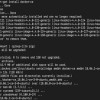[Hacking walkthrough] THM: Scripting

![[Hacking walkthrough] THM: Scripting插图 [Hacking walkthrough] THM: Scripting插图](https://sp-ao.shortpixel.ai/client/q_glossy,ret_img/https://byy3.com/wp-content/themes/byy3.com/images/post-loading.gif)
Howdy, welcome to another tryhackme CTF walkthrough. This is my personal favorite room because it involves scripting and ciphering. As you know, I’m a die-hard fan for forensic and programming :p . For your information, There are a total of 3 stages for this challenge where the first stage is decoding base64, port capture on stage 2 and finally, the hardest stage (perhaps), decrypting the AES-GCM block cipher. Let’s get started
Task 1: Base64
You are required to write a script to decode the base64 for 50 times. Bash and python, both works for you but I prefer python. Copy the following script and execute along with the file.
#b64.py
import base64
import sys
with open(sys.argv[1],'r') as my_file: data = my_file.read()
for i in range (0,50): data = base64.b64decode(data)
print(data)
my_file.close()$ python b64.py b64.txt![[Hacking walkthrough] THM: Scripting插图1 [Hacking walkthrough] THM: Scripting插图1](https://sp-ao.shortpixel.ai/client/q_glossy,ret_img/https://byy3.com/wp-content/themes/byy3.com/images/post-loading.gif)
Simple huh. Well, the best is yet to come.
Answer: HackBack2019=
Task 2: Capture the port
This is a fun challenge, to be honest. Your task is to follow the port and reveal the mathematic operation. You need to have basic knowledge on python socket, If you need a full guide on the socket python, I highly recommend this article. For me, I am a lazy person, well no doubt. So, I letting the python do the mathematic for me.
These are the flow of my code
1: Initialize port 1337 as staring port (Why? Read the page, duh)
2. Initialize the socket
3. Send an HTTP GET request
4. Read the response
5. Process the response (trim, replace, split)
6. Perform arithmetic
7. Repeat step 2 to 6 until STOP response
To avoid the script getting terminate due to connection refused error, I used ‘try’ and ‘except’ with ‘pass’. Alright, the code is right here (I know you need it)
import socket
import sys
import time
host=sys.argv[1]
port = 1337
number = 0
while 1: try: s = socket.socket() s.connect((host,port)) if (port == 9765): break old_port = port request = "GET / HTTP/1.1\r\nHost:%s\r\n\r\n" % host s.send(request.encode()) response = s.recv(4096) http_response = repr(response) http_trim = http_response[167:] http_trim = http_trim.replace('\'','') data_list = list(http_trim.split(" ")) port = int(data_list[2]) print('Operation: '+data_list[0]+', number: '+ data_list[1]+', next port: '+ data_list[2]) if(port != old_port): if(data_list[0] == 'add'): number += float(data_list[1]) elif(data_list[0] == 'minus'): number -= float(data_list[1]) elif(data_list[0] == 'multiply'): number *= float(data_list[1]) elif(data_list[0] == 'divide'): number /= float(data_list[1]) s.close() except: s.close() pass
print(number)$ python pn.py <Machine IP>For your information, the port on the webserver is recycling (there are a total of 35 ports). Which mean the port changing sequence is always fixed. If you miss a port because of the poor connection, don’t worry, you just need to wait for another round (140-second per round). Sit back and relax until you get the number. Just let me know if you have a better script ?
![[Hacking walkthrough] THM: Scripting插图2 [Hacking walkthrough] THM: Scripting插图2](https://sp-ao.shortpixel.ai/client/q_glossy,ret_img/https://byy3.com/wp-content/themes/byy3.com/images/post-loading.gif)
Here you go.
Answer: 344769.12
Task 3: AES-GCM
Here comes my favorite part, the block cipher. Oh yes!!!!!! Block cipher FTW. (cough) sorry. For this task, you are required to decrypt the AES-GCM mode block cipher. But before that, you need to make a socket connection (like the previous task) with the UDP server.
Alright, this is the flow of my code
1) Send payload ‘hello’ to receive the first response
2) Send payload ‘ready’ to reveal Keys, IV, and checksum for the flag
3) send payload ‘final’ TWICE to receive encrypted flag followed by the tag
4) Decrypt the flag
5) Check the plaintext with checksum. If checksum not match, repeat step 4
6) Print the plaintext if checksum match
import socket
import sys
import hashlib
from cryptography.hazmat.backends import default_backend
from cryptography.hazmat.primitives.ciphers import ( Cipher, algorithms, modes
)
host = sys.argv[1]
port = 4000
def AES_GCM_decrypt(key, iv, ciphertext, tag): associated_data = '' decryptor = Cipher(algorithms.AES(key), modes.GCM(iv,tag), backend=default_backend()).decryptor() decryptor.authenticate_additional_data(associated_data) return decryptor.update(ciphertext) + decryptor.finalize()
def SHA256_hash(hash_string): sha_signature = hashlib.sha256(hash_string.encode()).hexdigest() return sha_signature
s = socket.socket(socket.AF_INET, socket.SOCK_DGRAM)
s.connect((host,port))
s.send(b'hello\n')
data = s.recv(2048)
print(data)
s.send(b'ready\n')
ready = s.recv(2048)
print(ready)
checksum = ready[104:136]
hex_checksum = checksum.encode('hex')
print("checksum in hex: "+hex_checksum)
while 1: s.send(b'final\n') flag = s.recv(2048) s.send(b'final\n') tag = s.recv(2048) key = b'thisisaverysecretkeyl337' iv = b'secureivl337' tag = bytes(tag) ciphertext = bytes(flag) plaintext = AES_GCM_decrypt(key, iv, ciphertext, tag) hash_string = SHA256_hash(plaintext) if(hash_string == hex_checksum): print('flag is: '+plaintext) break
s.close()![[Hacking walkthrough] THM: Scripting插图3 [Hacking walkthrough] THM: Scripting插图3](https://sp-ao.shortpixel.ai/client/q_glossy,ret_img/https://byy3.com/wp-content/themes/byy3.com/images/post-loading.gif)
Not that hard huh.
Answer: THM{eW-sCrIpTiNg-AnD-cRyPtO}
Conclusion
That’s all for the short and simple scripting challenge. Hope you enjoy it. See you nex time ?

 admin
admin